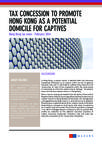At present, there are only two captive insurers in Hong Kong.
With a view to reaping the benefit from the policy of the Central People’s Government to encourage Mainland enterprises to form captive insurers in Hong Kong to enhance the risk management promulgated by the State Council in June 2012 so as to establish Hong Kong as a potential domicile for captive insurers and allow Hong Kong to compete on level terms with other jurisdictions as a captive insurance center, the Financial Secretary proposed in his 2013-14 Budget Speech in February 2013 to provide 50% profits tax reduction on the offshore insurance business of captive insurance companies. Therefore, they will enjoy the same tax concession as for reinsurance companies.
PROPOSED LEGISLATIVE CHANGE
To implement the profits tax concession for captive insurers, the government introduced the Inland Revenue (Amendment) (No 3) Bill 2013 (“the Bill”) which sought to amend the Inland Revenue Ordinance to give captive insurance companies a profits tax concession equivalent to that given to reinsurance companies for their offshore risks insurance business. This was gazetted on 27 December 2013 and first read by the Legislative Council (“LegCo”) on 8 January 2014.
In brief, if the Bill is passed, authorized captive insurers will enjoy concessionary profits tax rate of 8.25% (i.e. half of the tax rate of 16.5%) on the assessable profits derived from their business of insurance of offshore risks ascertained according to the given formula. This would take effect from the year of assessment 2013/14 onwards.
To enjoy the proposed profits tax concession, the taxpayer must satisfy the following requirements:
- It should be an authorized captive insurer as defined in the Insurance Companies Ordinance;
- It carries on the business of insurance of offshore risks as an authorized captive insurer; and
- It has elected in writing on an irrevocable basis that the tax concession applies to self.
Apart from the tax concession proposed in the Bill, there are other regulatory concessions currently available to captive insurers under the Insurance Companies Ordinance:
Item | Captive insurer | Non-life insurance company |
Minimum capital requirement | HK$2 million | HK$10 million |
Minimum solvency margin | The greatest of: a. 5% of the premium income; or b. 5% of the claims outstanding; or c. HK$2 million | The greatest of: a. generally 20% of the premium income; or b. generally 20% of the claims outstanding; or c. HK$10 million |
Requirement for assets in Hong Kong | Exempted | To maintain assets in Hong Kong of an amount not less than 80% of its Hong Kong net liabilities plus solvency margin |
Valuation regulation | Assets and liabilities to be valued on the basis of Generally Accepted Accounting Principles | Assets and liabilities to be valued according to the Insurance Companies (General Business) (Valuation) Regulation |
Authorization and annual fee | HK$ 22,600 | HK$ 227,300 |
The Bill was considered by the House Committee of the LegCo on 10 January 2014 and a Bill Committee was formed to study the Bill in detail. While the members of the Bill Committee expressed their support to the Bill during the first meeting held on 28 January 2014, a few members expressed their concerns on the following matters:
- How effective is the proposed concessional tax rate of 8.25% in competing with other jurisdictions, for instance, Singapore, Qatar and Bermuda, that already offer concessionary zero tax rate to approved captive insurers, though years of exemption might differ;
- Is it necessary to specifically define the meaning of “group of companies” in the Bill so as to confine the scope of corporation being qualified for the proposed concession instead of directly adopt “the group of companies” defined under the Insurance Companies Ordinance or Companies Ordinance;
- Any loophole for embarking in tax avoidance scheme for obtaining tax benefit with the Bill; and
- Did the Bill address the loss treatment in case captive insurers merged.
The government is expected to provide additional information on these concerns before the Bill Committee considers the way forward.
The tax and other regulatory concessions are all positive measures to attract more companies to set up captive insurers in Hong Kong. A low captive count remains a major downside to attract more companies to set up captive insurers in Hong Kong.
Although the tax concession is a good starting point, the government still needs to demonstrate its commitment to provide a suitable and favourable business environment for insurers to operate in Hong Kong.

